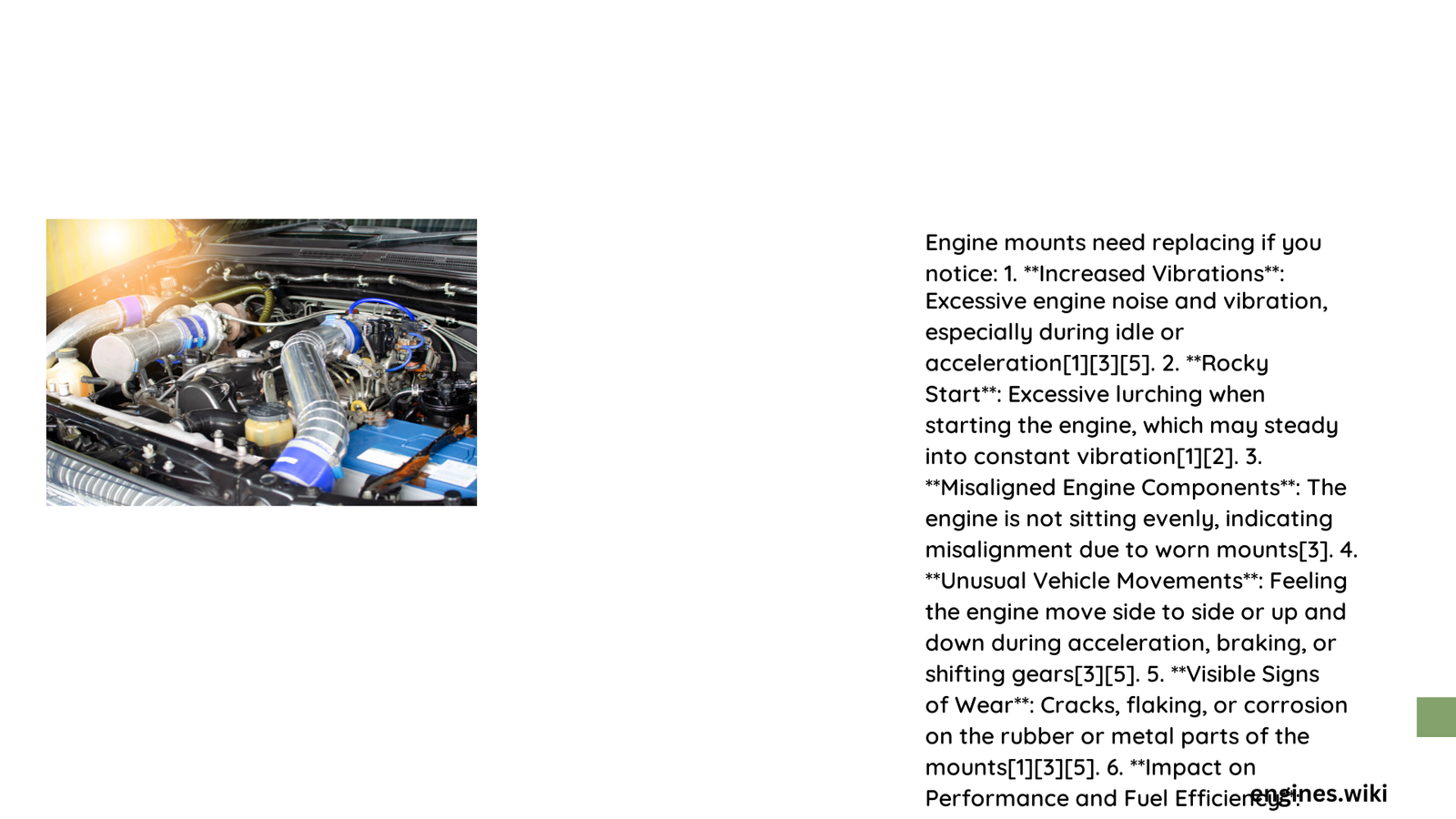Engine mounts are crucial components that stabilize your vehicle’s engine and minimize vibration transfer. When these critical parts deteriorate, they can compromise your vehicle’s performance, safety, and driving comfort. Recognizing early warning signs of engine mount failure can prevent costly repairs and potential mechanical damage, making timely identification and replacement essential for maintaining your vehicle’s integrity.
What Are Engine Mounts?
Engine mounts are rubber and metal components designed to:
– Secure the engine to the vehicle’s frame
– Absorb engine vibrations
– Prevent excessive engine movement
– Reduce noise and mechanical stress
| Mount Type | Material | Primary Function |
|---|---|---|
| Solid Rubber | Rubber | Basic vibration absorption |
| Hydraulic | Fluid-filled | Advanced vibration dampening |
| Polyurethane | Synthetic | High-performance, minimal flex |
What Causes Engine Mount Wear?

Several factors contribute to engine mount deterioration:
– Age and mileage
– Extreme temperature variations
– Aggressive driving habits
– Poor road conditions
– Manufacturing defects
How Can You Detect Failing Engine Mounts?
Are There Visible Signs of Damage?
Inspect engine mounts for:
– Visible cracks
– Rubber deterioration
– Metal corrosion
– Separation from mounting points
Do You Notice Unusual Vibrations?
Characteristic vibration indicators include:
– Intense shaking during acceleration
– Noticeable engine movement
– Vibrations increasing with engine RPM
– Tremors felt through steering wheel
What Sounds Suggest Mount Failure?
Listen for distinctive noises:
– Clunking sounds during gear shifts
– Banging noises under acceleration
– Metallic thuds when stopping or starting
– Rhythmic thumping at idle
Can Misalignment Indicate Mount Problems?
Check for:
– Engine sitting at an unusual angle
– Uneven weight distribution
– Visible shifting during vehicle operation
What Are Potential Consequences of Ignored Mount Damage?
Neglecting worn engine mounts can lead to:
– Accelerated component wear
– Transmission damage
– Compromised vehicle handling
– Increased repair costs
– Potential roadside breakdowns
When Should You Replace Engine Mounts?
How Often Should Mounts Be Inspected?
Recommended inspection intervals:
– Every 30,000-50,000 miles
– Annually for high-mileage vehicles
– Immediately upon noticing symptoms
What Is the Replacement Process?
Professional replacement typically involves:
1. Vehicle lifting and securing
2. Disconnecting engine mounts
3. Removing old mounts
4. Installing new, manufacturer-recommended components
5. Torquing to precise specifications
Professional vs. DIY Replacement
| Approach | Pros | Cons |
|---|---|---|
| Professional | Guaranteed work, diagnostic accuracy | Higher cost |
| DIY | Cost-effective, learning experience | Requires technical skill |
Conclusion
Proactive monitoring of engine mount condition is crucial for maintaining vehicle performance and preventing expensive repairs. Regular inspections, attentive listening, and prompt action can significantly extend your vehicle’s lifespan and ensure safe, comfortable driving.
Expert Tips
- Use quality replacement mounts
- Follow manufacturer specifications
- Consider professional installation
- Address symptoms immediately
Reference:
– GMT Rubber: Engine Mount Symptoms
– Mt Roskill Collision: Mount Diagnostics
– Firestone Complete Auto Care: Mount Maintenance
